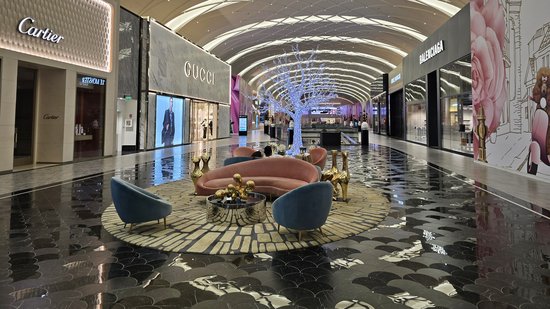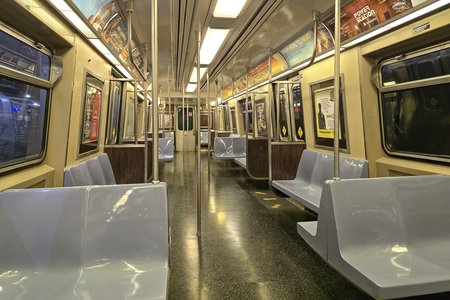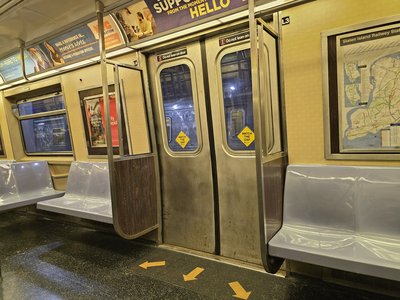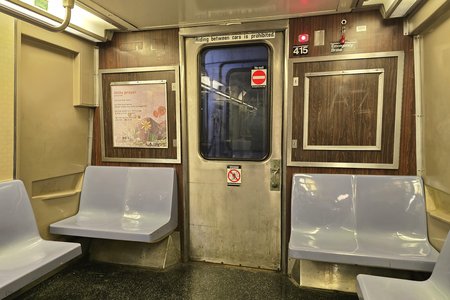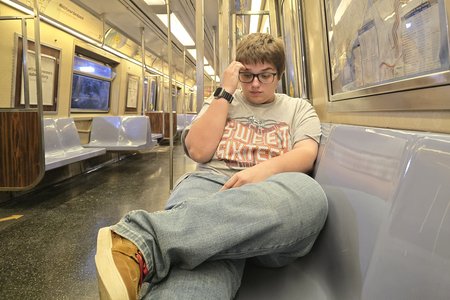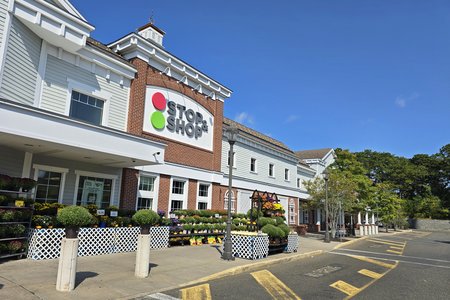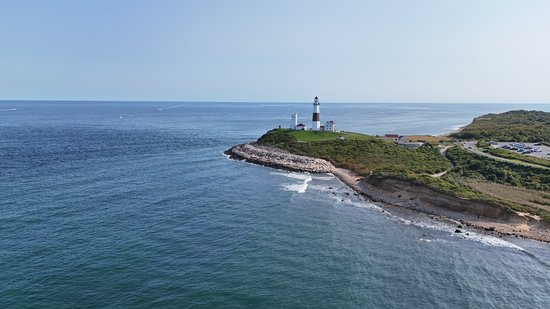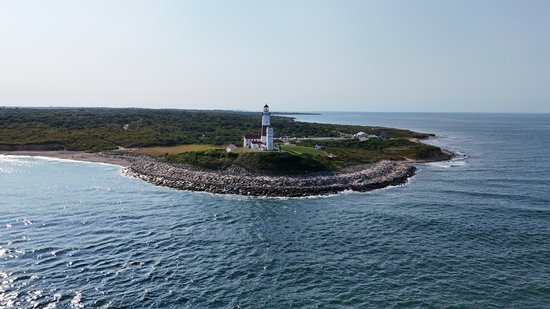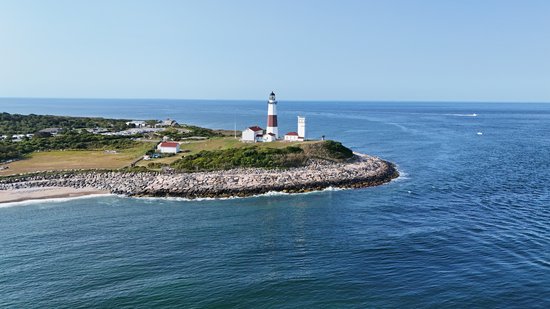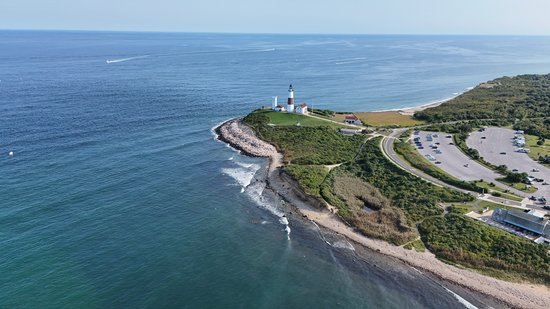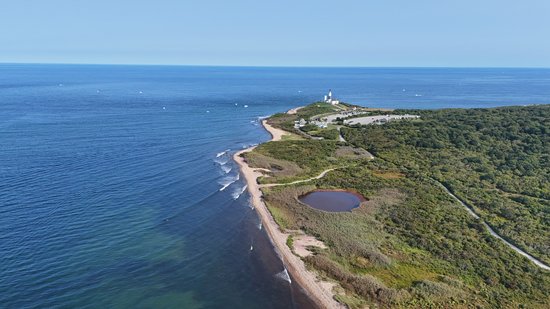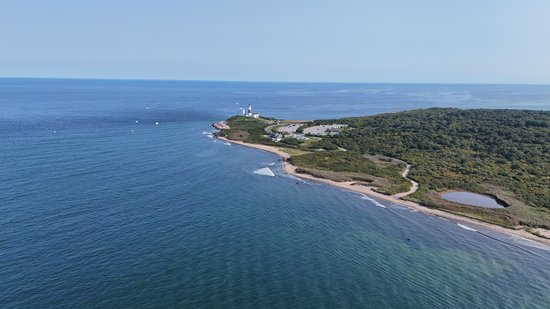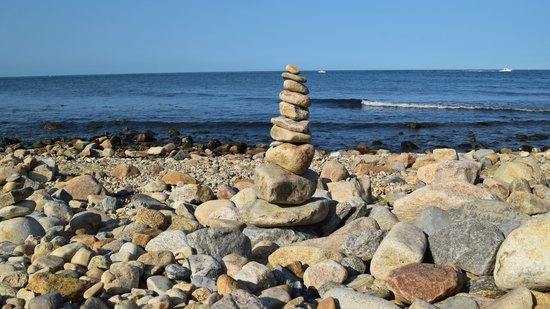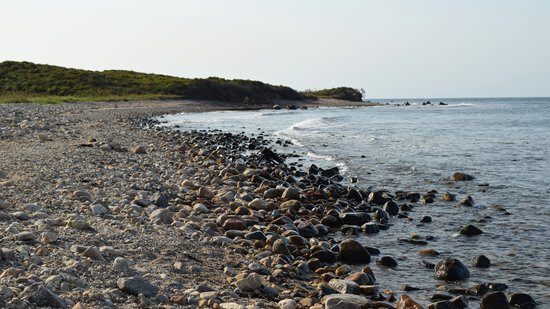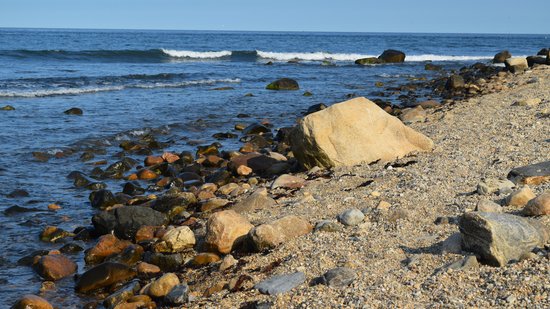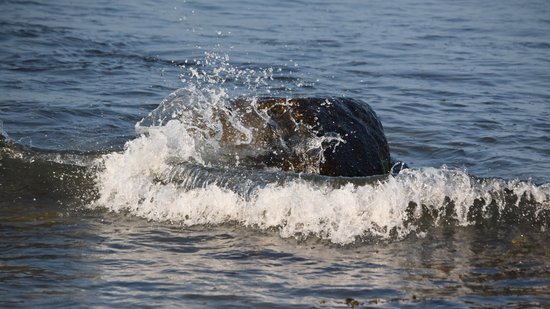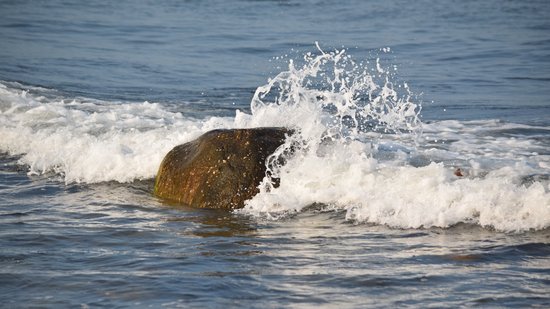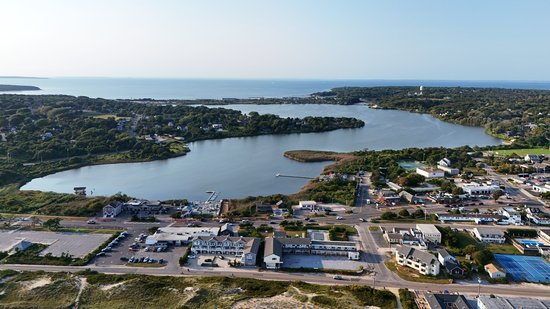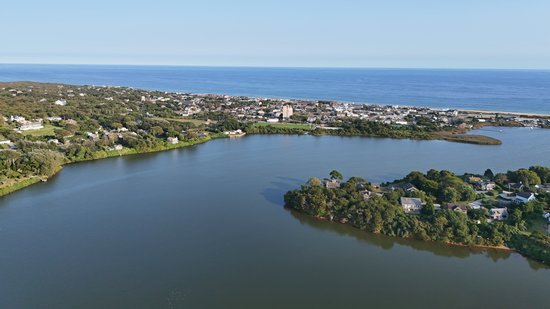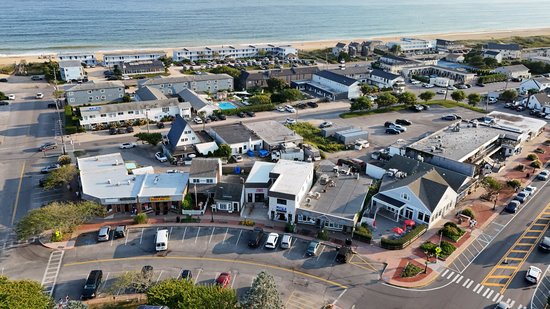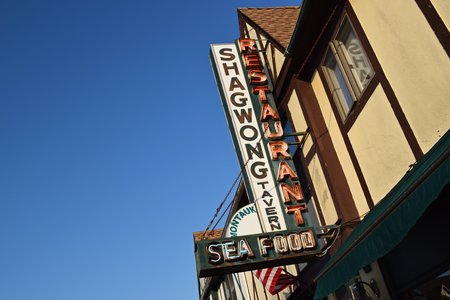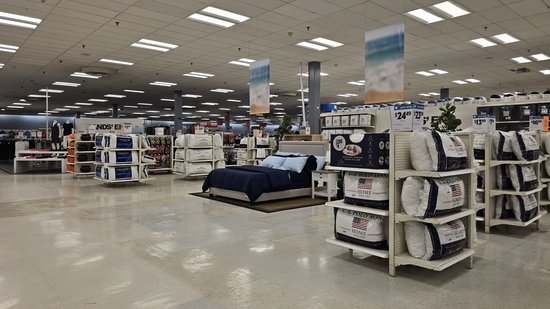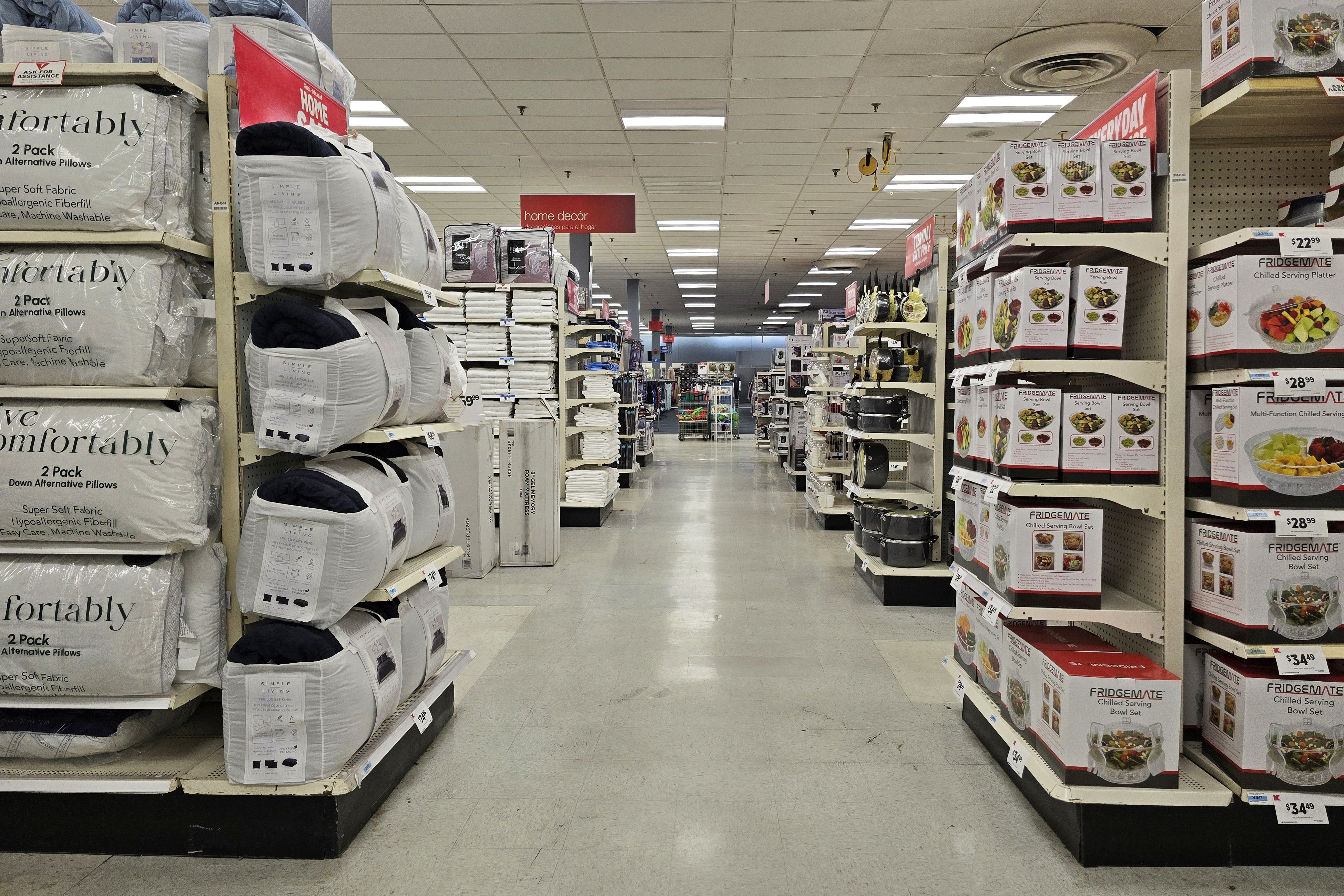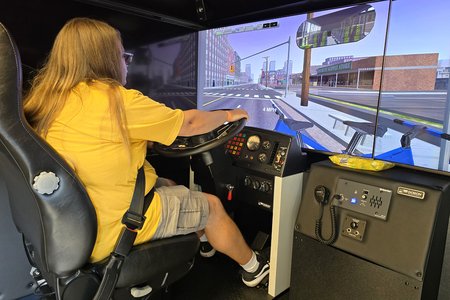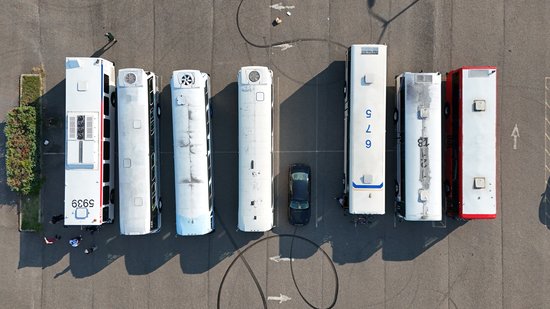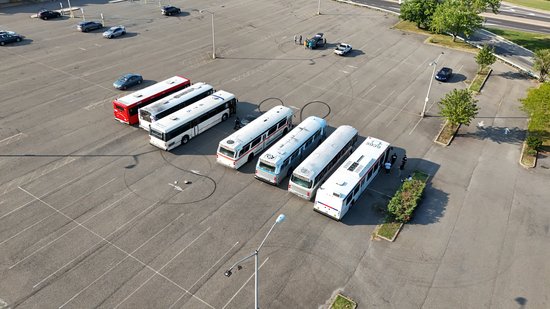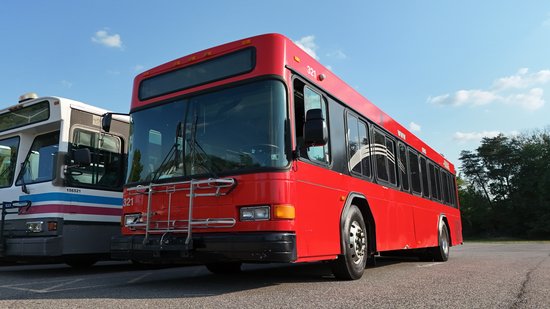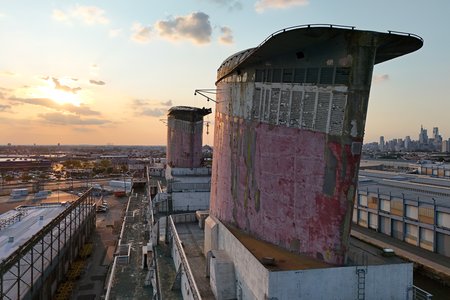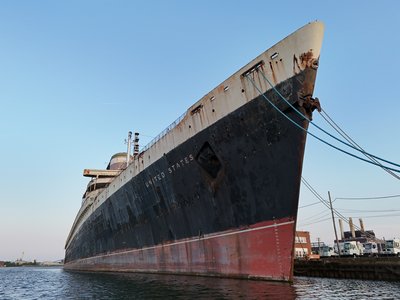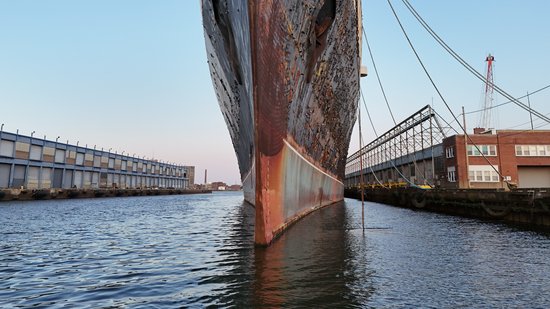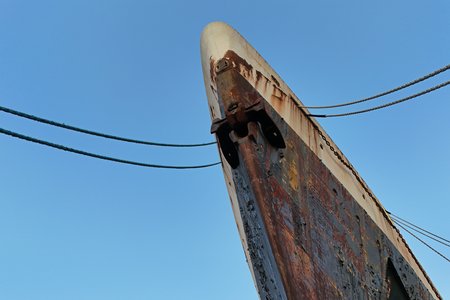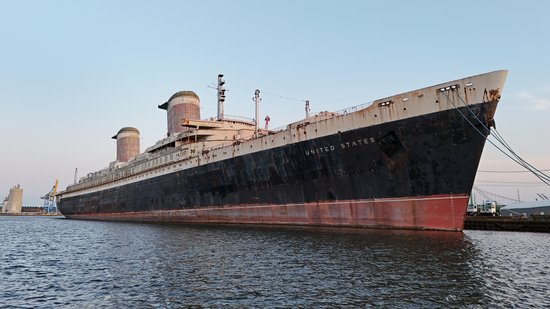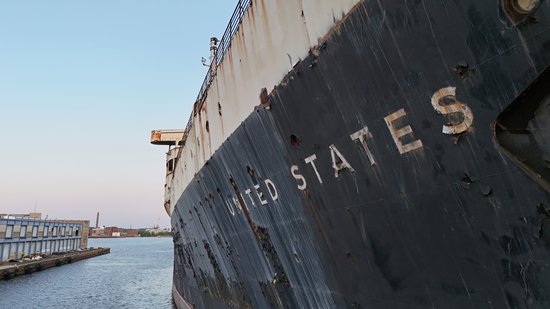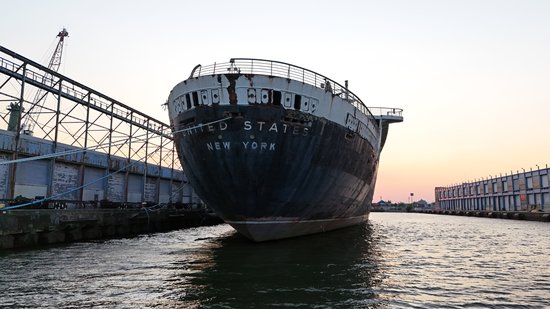A visit to New Jersey and Long Island…
32 minute read
September 21, 2024, 3:34 PM
From September 12-14, Elyse and I, along with our friend Kyle, took a weekend trip up to North Jersey and Long Island. This trip was designed as a bunch of different things that we wanted to do in the same general area, mashed together into one trip. Elyse wanted to see the American Dream shopping mall, and I wanted to see it again when I didn’t have COVID. So that was our first day. I wanted to see what Long Island was about, plus see one of the last remaining Kmart stores in the country, which is out in Bridgehampton, New York, so we went out to the end of Long Island on the middle day. Then the third day was a bus show in Howell Township, which we all wanted to see, and then we went through Philadelphia on the way home to photograph the SS United States for what might be the last time. Our hotel was a Hampton Inn in Staten Island, intended to be kind of midway between these three very diverse locations. This trip, in the form that it took, was relatively quickly planned. The only constant here was the bus show, as that was the primary driver of our making the trip in the first place, and then we just added on the rest to make a weekend out of it. The original plan, had the oil pump not quit on us, was to take 3426 on this trip and display it at the bus show. With the bus, we would have still done American Dream and the bus show, but we would have stayed closer to Howell, and Long Island would have been replaced with the Jersey shore (since I didn’t want to drive a bus all the way out to the end of Long Island). I’ll say this: as much fun as it would have been for this to be a bus trip, I’m glad that we ended up doing it in the HR-V. There will be other bus events, but this just worked out well as a car trip.
Going up, I certainly demonstrated my New Jersey cred in the car. In other words, pay no attention to that Maryland license plate. I am originally from New Jersey, and I know how to drive like I’m from New Jersey, a place where signs and pavement markings are just suggestions, and you have to keep up with the big dogs in order to get where you’re going. If it tells you anything, prior to leaving the house, I posted on Facebook, “Going up to New Jersey today for the weekend, and thinking about how people up there drive like they’re from New Jersey. Then I was like, ‘Wait a minute… *I’m* from New Jersey!’ So I’ll be driving amongst my peers, despite my Maryland license plate.” We took the Turnpike from the bottom all the way to exit 16W, and I handled it like a champ.
At American Dream, we parked by the upscale wing of the shopping center, and went in that way. In the eight months since the last time that I visited the place, I feel like it had improved somewhat, as I noticed fewer unbuilt spaces than before (but don’t worry, there were still a whole lot of those). The crowding level at the mall was similar to what it was when I visited in January, so I don’t know if the sparse attendance is normal for American Dream outside of the holiday season, or if I just happened to catch it on a particularly slow night again. This was a Thursday evening in September, while my first visit was a Friday evening in mid January when it had been snowing earlier in the day. As far as our movements in the mall went, when I visited in January, we made the loop around the entire mall, but we didn’t go down every single corridor on all of the mall’s three levels. Rather, we made one loop, moving between floors as we went. We did the same thing here, so I got to see different parts of the mall than before.
Here’s what we saw this time around:
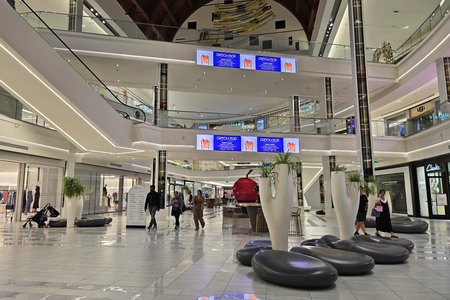
One of the mall’s many courts, viewed from the lower level.
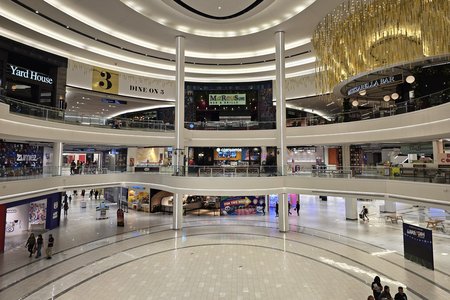
Another court, viewed from the middle level.
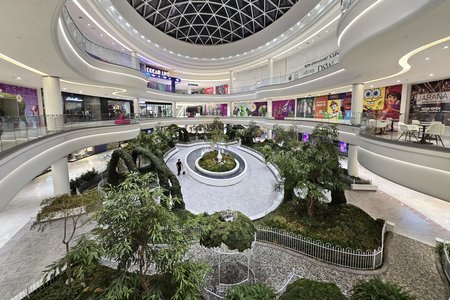
A court with a garden layout, viewed from the middle level.
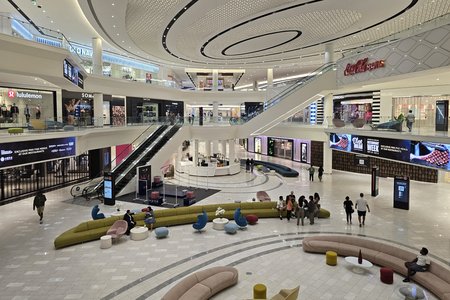
Court containing the guest services counter, viewed from the middle level.
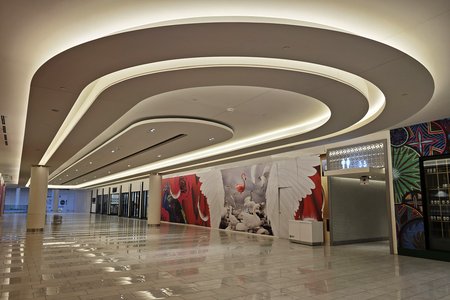
A corridor lined by unbuilt tenant spaces, on the third level.
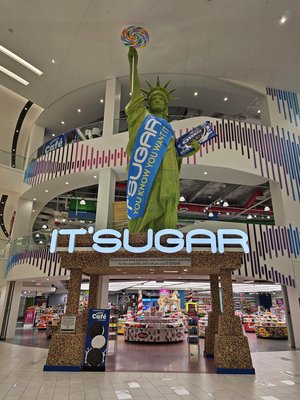
Giant Statue of Liberty replica in front of the It’Sugar store, across from Nickelodeon Universe.
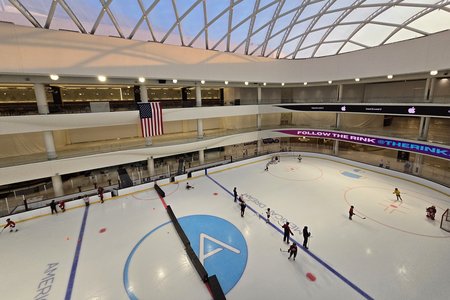
The ice rink, which I missed photographing last time, viewed from the third level. Note that almost all of the retail space in the background of this shot is unbuilt.
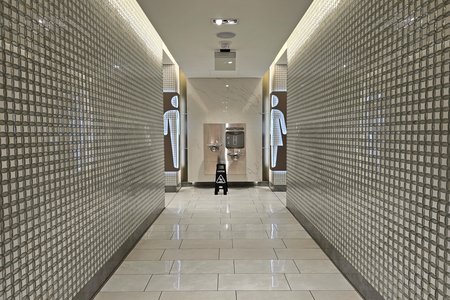
Another view of one of those gaudy looking bathroom corridors. Someone needs to tell them that less is more.
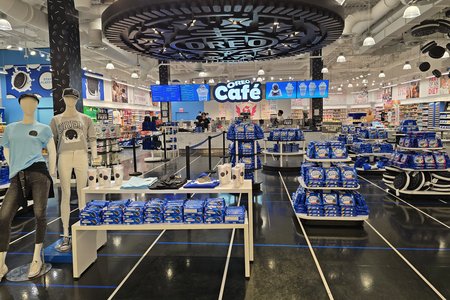
The Oreo store, which I had missed in January. This sells all sorts of Oreo-related products, and that “Oreo Cafe” back there sells ice cream and the like.

We briefly peeked in at Nickelodeon Universe, and I was surprised to find a Plinko game, like one would find on The Price is Right. Normally, I’ve seen arcade games built in the spirit of Plinko with different theming, but never directly branded as Plinko.
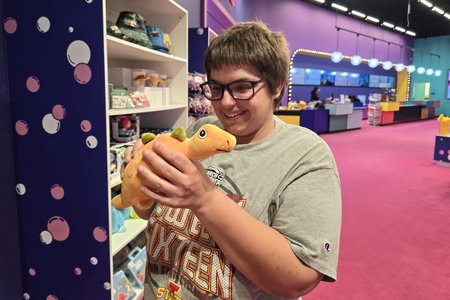
Elyse holds a toy dinosaur at Dream Live, which was hosting a place called “Bubble Planet” at the time of our visit.
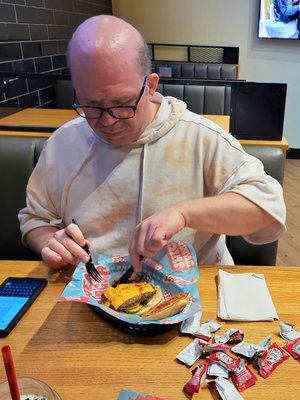
Kyle got this photo of me eating at the MrBeast Burger restaurant in the mall. Both Kyle and Elyse found it interesting/disturbing that I dissected it, eating it with a knife and fork and consuming each ingredient separately rather than picking it up and eating it as a whole.
Then there was the upscale wing, which takes the gaudiness of the mall as a whole and turns it up to eleven. A commenter in an online forum described American Dream as “flashy and trashy”, and I find it hard to argue with that characterization, particularly in the upscale wing, as if it was someone’s misguided conception about the kind of decor that rich people like, because the result sure isn’t tasteful, and comes off far gaudier than the rest of the mall, which is already pretty gaudy.
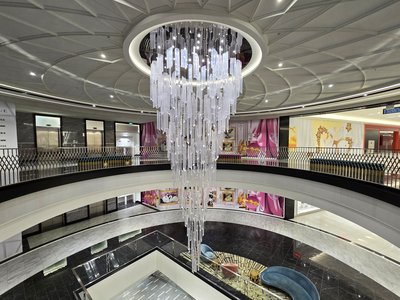
Chandelier in the upscale wing.

So apparently, I was wrong about the status of the Balenciaga store back in January. I thought that it had been and gone, but as it turns out, it was on its way in. Here it is, fully completed. However, due to time constraints, we did not visit.
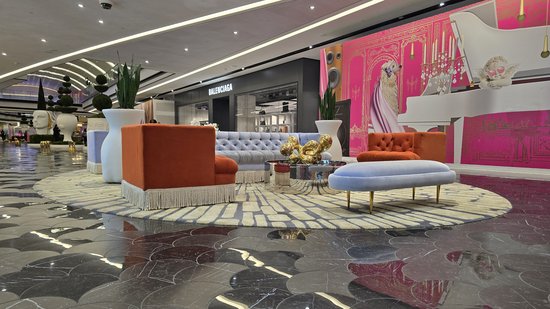
Seating areas in the upscale wing.
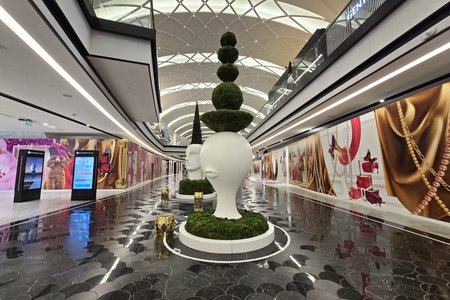
Some very interesting looking sculptures in the upscale wing. It seems to exemplify “flashy and trashy” to me.
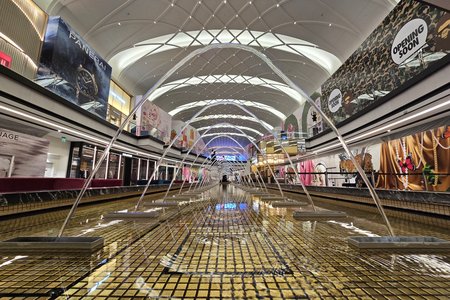
Long fountain in the upscale wing. Admittedly, other than the gaudy color scheme, the fountain was executed fairly well.
And that was our time at American Dream. Things appear to be gradually improving there, as it felt more full than it did in January. I consider that to be a good thing, though I suspect that it will be many, many, many more years before it reaches anything remotely resembling full occupancy.
From there, we left New Jersey, and headed to Staten Island, where our hotel was located. We were staying at a Hampton Inn there, which, surprisingly for New York City, was a standard Hampton Inn that you would find anywhere, complete with complimentary self-parking. That was very different from where we usually stay, at the Aloft in Brooklyn, where the HR-V goes to a third party’s parking garage on the other side of the block. But this was Staten Island rather than Brooklyn, plus that sort of parking arrangement wouldn’t work for what we had planned, as the middle day would not be a New York trip, but rather a road trip out to Long Island.
However, before we did that, we had some transit to fan. Since we were on Staten Island, there was no better time to do the Staten Island Railway (SIR). The SIR, for all intents and purposes nowadays, is essentially an exclave of the New York Subway, as it is operated by the MTA and uses modified R44 cars for rolling stock. We did a round trip on the line, going from Tottenville to St. George and back.
And this is what we saw:

Car 392 at Tottenville station. Unlike the regular NYC Subway, which uses four-digit car numbers, the cars used for SIR service have three-digit numbers.
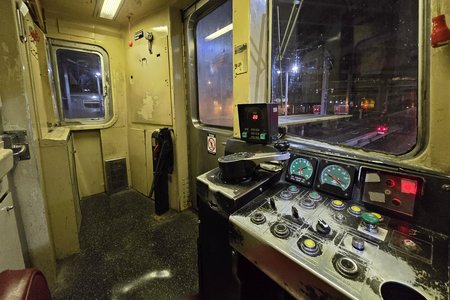
Operator’s cab on car 392. This is a much older design than the cabs that I’m accustomed to working in, but it still looks quite familiar, as a train is a train to a certain extent. I was most surprised that the emergency brake was a pull cord above the operator, while my agency’s trains use a red mushroom-shaped button on the operator’s console.
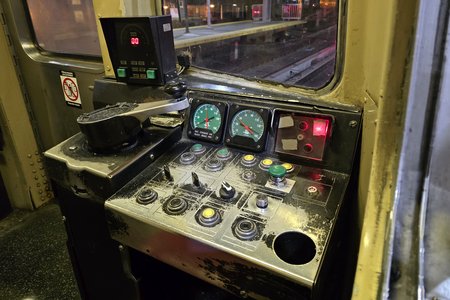
Close-up of the console on car 392. The details may be different, but after looking at this for a few minutes, I felt right at home. I could definitely operate this beast with little difficulty, once I got used to their master controller.
Meanwhile, if anyone was wondering how I got these cab photos, they left the window open, so I reached in with my arm and helped myself. We also had a few minutes to be able to “talk shop” with one of the employees. It’s interesting discussing the differences between our various transit systems, and what we each consider normal.

Bump post at the end of one of the tracks. From what we could tell, this track was where the chaining started, as this track extended furthest out before terminating. We saw another track nearby with a 00+54 chain marker fairly close to the bump post, i.e. it certainly wasn’t 54 feet from that marker to the end of the track.
And then this was right nearby:
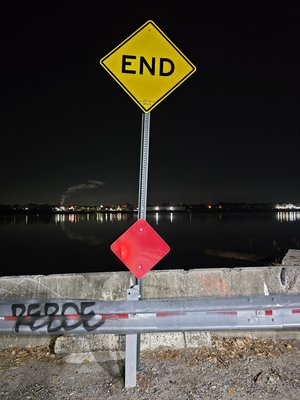
“END” sign marking the end of Bentley Street. Any further, and you would be in the water. I was taken back by the brevity of the sign message. I’ve seen similar endings with “DEAD END” before, a row of those red diamonds to mark the terminus, or “ROAD END” in one instance in Baltimore County, but never just “END”. Apparently, that’s a common thing in New York City.
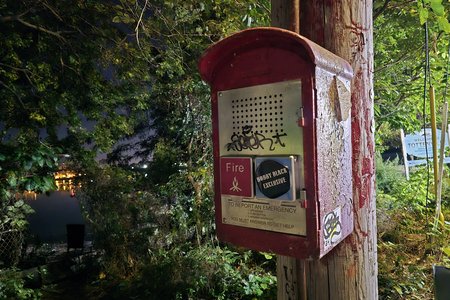
Standard NYC-style fire and police call box, next to Tottenville station.
And that was it for the first day. The next day, we got up and got breakfast, discovering, much to our surprise, that this particular Hampton was also offering chicken nuggets with the breakfast service. I had never seen that before, and I wasn’t about to complain. Elyse described it as an autistic person’s dream food. I couldn’t disagree with that assessment. My plan was to get going right after rush hour ended, but that didn’t happen, as Elyse was a bit slow getting started. Such, unfortunately, is what happens when Elyse is feeling unmotivated in the morning (make a note of that, as we will be revisiting that later). Our travels would take us all the way out to Montauk, at the easternmost end of Long Island, with the idea of going all the way out to the end of Long Island and seeing that first, and then doing whatever else we wanted to do on the way back. That ensures that we get to the furthest extent of our travels first, and relatively quickly, and then as the day continues to wear on, we’re getting closer to our end. I’d much rather do that than plow forward and do our activities on the way out, and then end up at the end of our path late at night and have to drive four hours back to to hotel when I’m tired. Thus getting the hardest part of the drive done first.
However, we did have to make a couple of stops on the way out. First, I got a tire pressure warning fairly soon after we hit the road, so we stopped in at a Valero station in Valley Stream and checked on that. Turned out that the left rear tire was low, so I aired that up, and we were off. This was the second time that tire set off the low pressure warning in recent months, as this happened at the start of the Harrisburg trip as well. In both instances, though, I got no further warnings on the trip, but it is something that I will need to get looked at, as I suspect that something might be up with that tire, because if it’s happened twice, odds are good that it will happen again in the future.
Then our next stop was at a Stop & Shop in Hampton Bays, which was a food and restroom stop:
For those of you in the DC area who aren’t familiar with Stop & Shop, it’s owned by the same parent company as Giant, and the stores are identical. Both stores previously used the fruit bowl logo, though Stop & Shop later changed its logo again to something more closely resembling its original logo, as seen above.
After that, we nonstopped it to Montauk. On the way, after the freeway ended, and NY 27 became mostly a two-lane road known as Montauk Highway, we went through the various towns that comprise “The Hamptons“. One thing that we noticed pretty quickly was how well-heeled the area was, especially going down Main Street in East Hampton, and seeing all of the upscale stores in their downtown area. That was a bit of a shock to see, but not surprising, either.
We made it to Montauk Point just before 4:00 PM, and we each did our own thing there. I parked the car, got my drone and my DSLR, and went to work photographing the end of Long Island. We all had to admit that Long Island certainly lives up to its name, as it was indeed quite a long drive to get across it. If it tells you anything, we were as far east as Westerly, Rhode Island on the mainland, and this also marked the easternmost point that the new HR-V has been (only my old Mercury Sable has been further east with me).
Here’s what I got of Montauk Point with the drone, flying from my base on the north side of Montauk Point:
Besides the point itself, I also took a moment to look outward:
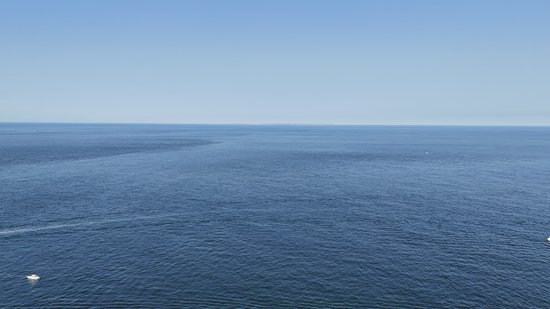
The view facing out from Montauk Point. If you look carefully, you can see Block Island out in the distance, which is part of Rhode Island.
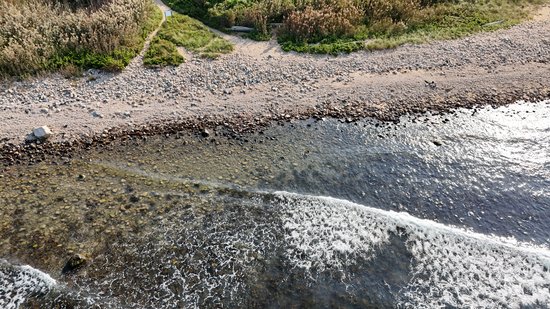
Preparing to land. The landing on this one was more challenging than most, mainly because the drone recorded the home point incorrectly due to a lack of proper satellite fixes during launch, ultimately placing it about 100 feet out over the water. So, knowing that the home point was wrong, I had to make extra sure that I knew exactly where the drone was at all times in relation to me, and be extra careful about how much battery I had remaining, because a return to home would only get me so far this time, and I would then have to fly it back manually. Fortunately, my careful planning paid off, as I made a perfect landing right next to where I was standing with plenty of battery to spare.
After the flight was over, I took some photos with the DSLR, focusing on various stacks of rocks that I found in my immediate vicinity, as well as the surf.
I don’t know why they were there, or if they have any particular significance to anyone (guessing some tourist did it to amuse themselves), but they were fun to photograph.
Then I photographed the beach:
Then I photographed the surf splashing over some of the larger boulders in the water:
I also got a selfie while I was there:
After I got back to the car, and moved around to pick up Elyse before continuing on, I spotted a rare specimen:
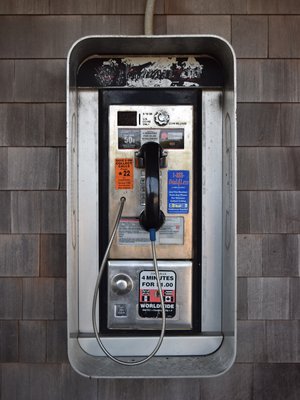
It’s not often that you see a payphone nowadays. Though it’s understandable here. The cell service here was good enough, but not full bars. Having a public fixed link to the telephone network here seems beneficial.
Finishing up here, we headed into the town of Montauk. From what I could tell, Montauk is more or less a beach town, and has a certain level of charm to it. I put the drone up in the air and got some aerials:
Then I got out and got a few photos with the DSLR:
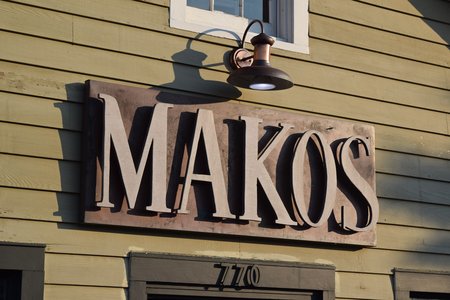
Mako’s Vintage, a little clothing shop.
Then, after collecting Elyse and Kyle, we were off, continuing westward back down Route 27. Our next stop was Bridgehampton Commons, which is probably best known for being the location of the last full-size Kmart store in the continental US. There is one other Kmart location in the continental US in Miami, Florida, however, that location has been downsized considerably, with the remainder of the space’s being subdivided for use by other tenants. That means that Bridgehampton is essentially the last of its kind. Here it is:

A living, breathing Kmart store in Bridgehampton, New York.
This store received updated Kmart signage in the last few years, as historically, this location had blue signage, which was previously used throughout the shopping center, and led Elyse and me to call it the “Blue Kmart”. Apparently, the new signage came when the shopping center did an update that eliminated all of the blue signage in favor of each brand’s normal colors.
Inside, the store looked more or less the way that Kmart ought to look. It was clear that it was still end-stage Kmart, but it wasn’t bad, either. The signage was in two different styles. One style was the red Sears-style signage that was introduced after Kmart acquired Sears, and the other style was from the chain’s final years, matching those cheesy blue t-shirts that the company dressed the employees in during that period. The store also had some unique things that I had never seen before at a Kmart, with the walls’ being painted a powder blue color, and dark blue carpeting in the clothing areas. Most Kmarts that I was familiar with in recent years had either white or red walls, and had tile across the entire store, clothing areas and all.
So let’s take a look at this, the last true Kmart store in the continental US.
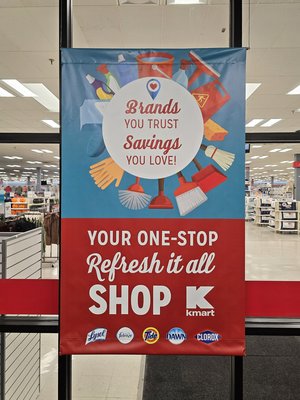
The vestibule had a banner welcoming you to Kmart, positioning the store as the one-stop shop for home cleaning supplies.
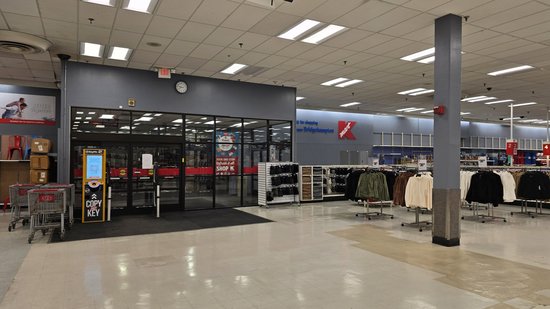
Just inside of the vestibule. Note the powder blue walls.

The homelines areas of the store were fairly well stocked. Lots of product, and a decent selection, with none of the trickery that some stores used in their waning days, stacking the same product one deep on the shelves across a wide range of space in order to make the shelves look full. They didn’t need to do that here because, by and large, the shelves actually were pretty full.
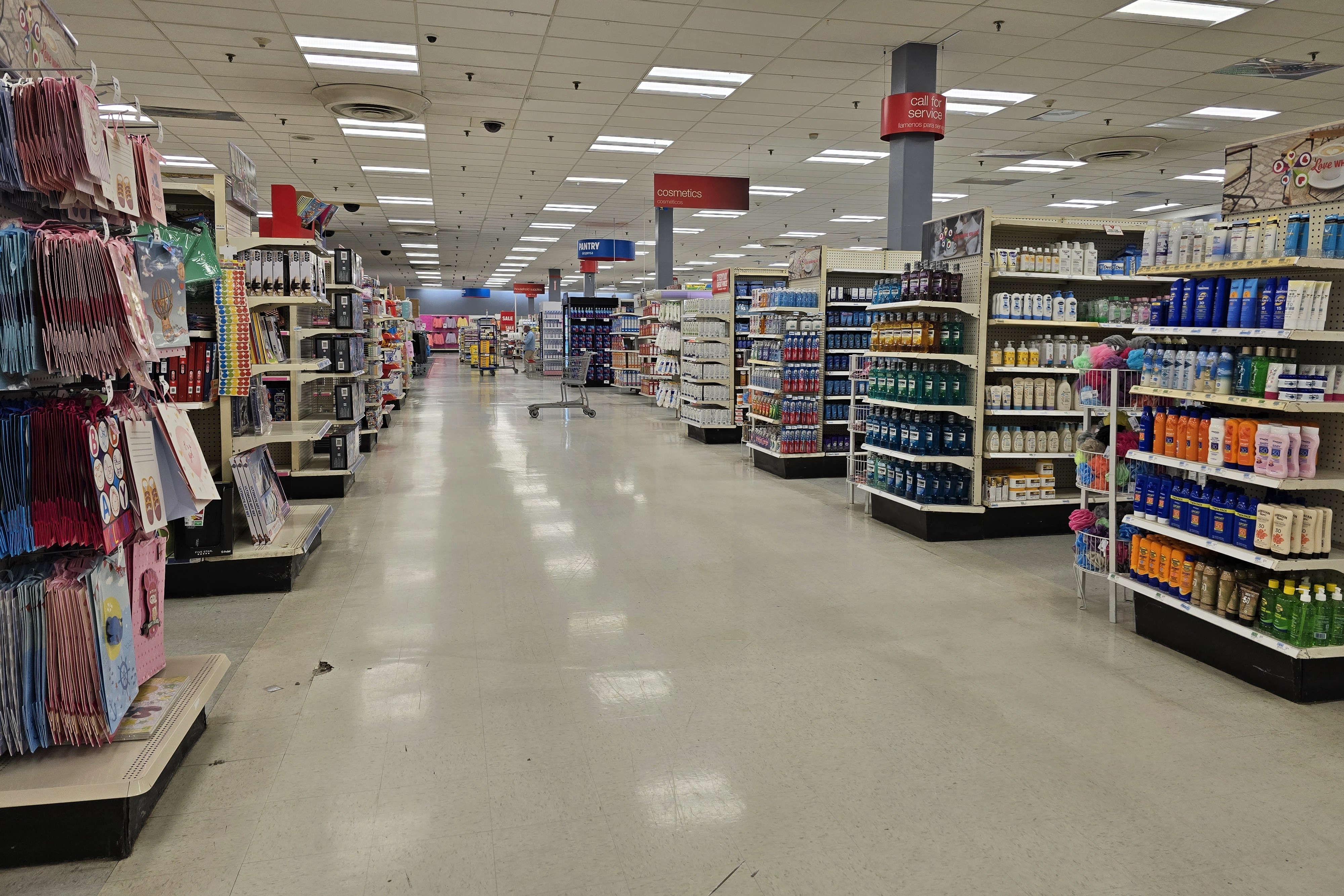
Back action alley at the Bridgehampton Kmart. Note the mixture of Sears-acquisition-era signage, and later signage that matched the employee t-shirts.

There were a few places where the merchandise selection was somewhat odd, like this very large selection of patio chairs towards the front of the store. I suspect that with only six Kmart stores remaining (this one, Miami, Guam, and three in the US Virgin Islands) and no more distribution centers, any excess inventory just gets put out on the salesfloor. This sort of gave me “end-stage Kmart” vibes, as it was clear that despite this store’s appearing to be pretty healthy, the company as a whole was still a shell of its former self.
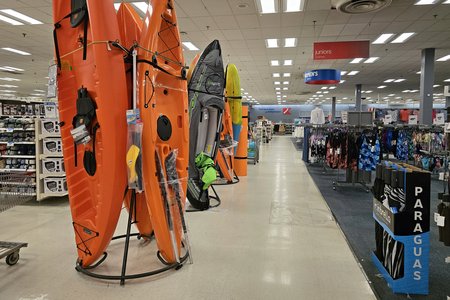
This strategy of just throwing the merchandise out on the salesfloor continued with this random display of kayaks in the center action alley, comprising the only large sports equipment that we could see.
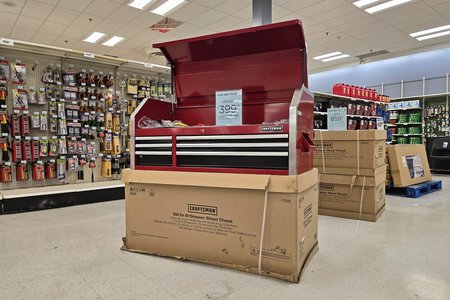
A large Craftsman tool chest for $399.99. On the whole, for a high quality tool chest like that, it’s hard to argue with that price.

The grocery aisles were largely well-stocked, and looked like a grocery section ought to look, with a combination of national brands and private label brands.

The left side of this aisle in the grocery section, containing Evian bottled water, was the only part of the store where product was stacked across a wide area one-deep to make a section appear full.
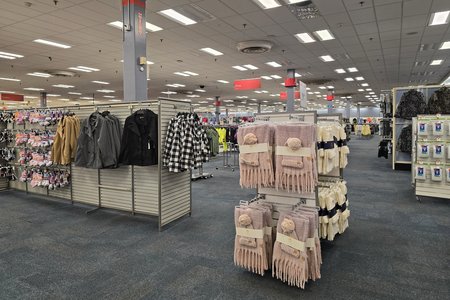
The clothing areas were well kept, with blue carpeting throughout. My only complaint about the clothing areas is that they seemed darker than the rest of the store (look at the ceiling). I suspect that this is because the darker blue carpet does not reflect the light back like the beige-colored tile does, creating the darker appearance.
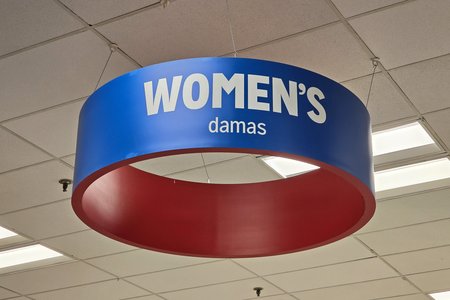
End-stage era signage in the women’s clothing area.
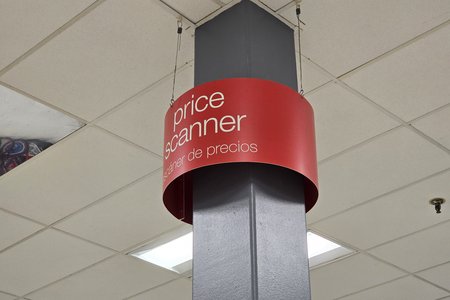
2000s-era Sears-style price scanner sign on a structural column.

The price scanner, meanwhile, was vintage, complete with Big Kmart and Super Kmart logos on it. Both Big Kmart and Super Kmart are now completely extinct, as all Super Kmart stores have closed (the last one closed in 2018), and all Big Kmart stores either closed or, as was the case here, were rebranded back to just plain Kmart. But to their credit, the price scanner still worked.

Shopping cart at the Bridgehampton Kmart. None of the carts that I looked at contained any specific Kmart branding that I could find, and most likely were generic metal carts with red trim.
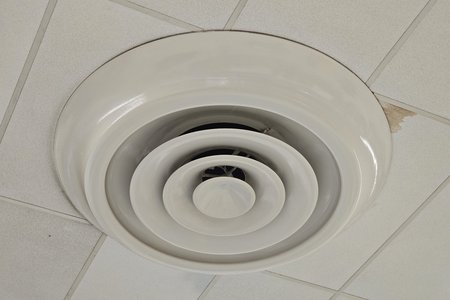
Look at that ceiling vent. If anyone needed any proof that this store is a Kmart, there you have it. Elyse calls these “Kresge vents”, because they were found in the ceiling at most Kmart stores.
The store, however, was not without its flaws, and we found quite a few noticeable ones.
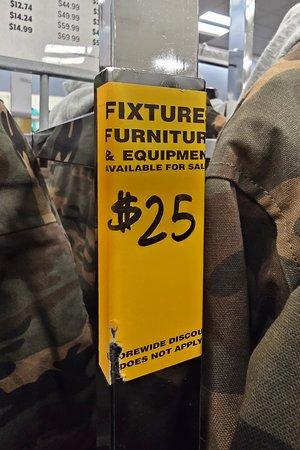
Elyse spotted this in the men’s clothing department. This four-way clothing rack contained a liquidation sticker listing a price of $25. We suspected that this rack had been transferred from a closing store elsewhere, and they just never removed the sticker.

Four damaged tiles with missing sections in the back action alley of the store. This constituted a trip hazard, as it would be easy to catch your toe on this if you didn’t spot it ahead of time.

Four-way rack in the back action alley of the store, held up with a garden brick. Elyse, Kyle, and I all looked at this and were like, “Really?”
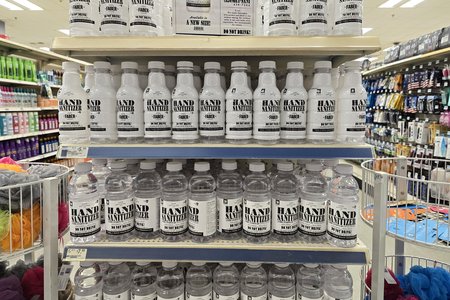
Endcap full of Faber-branded hand sanitizer bottles. This was a common sight during the COVID pandemic, but I had not seen it at all in more recent years. I suspect that this is a pandemic-era holdover, i.e. they were never able to move it, and so it remains on the salesfloor for the rest of whatever. My suspicions that this is a holdover were helped by the fact that the store was still running COVID-era PSAs that asked shoppers to maintain social distance and wear a mask, despite that the pandemic had been over for more than two years at this point.

A product oopsie here – what is a Home Depot-branded cooler doing at Kmart?
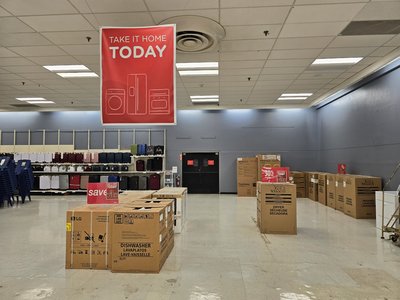
Despite this store’s seeming healthy and well-stocked, there was still a good bit of empty space in the store, though not enough to warrant walling off sections of the salesfloor with shelving like some stores did in their final months.

One section in the front of the store contained a lot of location-specific merchandise. There were rashguard shirts and hoodies and other clothing items containing the names of various locales in the area, like Bridgehampton, as Elyse shows off here (we ultimately bought this shirt), as well as Sag Harbor and others.
The amount of tourist-themed merchandise, plus the kayaks and other things, made me wonder how much of this store’s business is derived from vacationers to the area. That might explain why it was so well stocked, and why, despite its being the only big-box store around (the nearest Target is about 24 miles away, and the nearest Walmart is about 35 miles away), plus the furthest-out big-box store on Long Island (it’s about four-fifths of the way down the island), it was sparsely attended when we visited, plus only had about six employees working at the time. It was mid-September, after all, which would be off-season for beachgoers. I imagine that this store does good business during the tourist season, though.
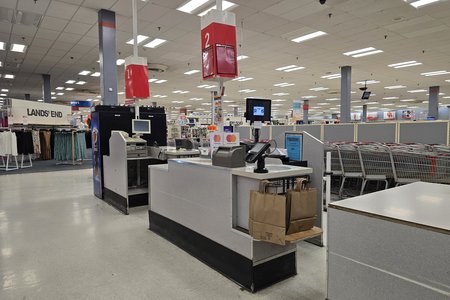
The front end, meanwhile, looked like what you would expect for a Kmart store. However, according to the employees, they did upgrade the cash registers to new equipment by Storis a few months ago. That told me that this store was not just hanging on, but was clearly still a going concern. After all, they wouldn’t invest in new point of sale equipment if they were planning to shutter the place. Similarly, the powder blue walls are relatively recent, as images posted to Google Maps as recently as two years ago showed the store with white walls and a blue stripe near the ceiling. Investment in the store, i.e. remodeling and new equipment, is definitely a sign that the company intends to keep this store going for the foreseeable future.
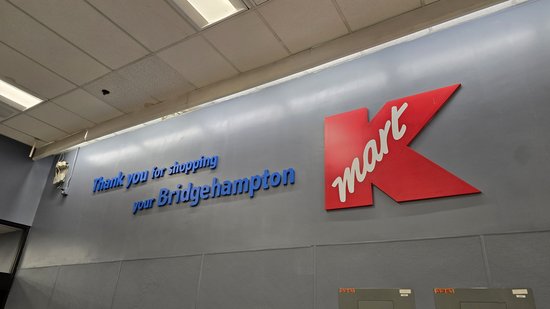
“Thank you for shopping your Bridgehampton Kmart” signage at the exit, using the 1990s-era Kmart logo.
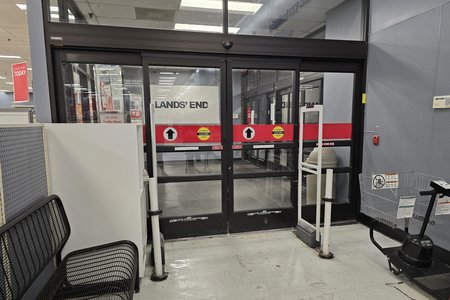
Exit doors leading back to the vestibule.
When it was time for us to go, I really didn’t want to leave. After all, we all knew that this would probably be our last time ever going to Kmart, because it was very unlikely that our travels would take us this far down Long Island again for the foreseeable future, and who knows how long this store will continue before it inevitably closes, and Kmart’s story finally comes to an end. I suspect that this store continues to hang on because it’s nowhere near any other big-box retail, much like that Kmart location in Guam. I also suspect that if this store ever closes, Target would snap the location right up and open its own store here.
Once we were back out in the parking lot, we all got a few last shots of the store.

The signage on the cart corrals appeared fairly recent, and was specifically made for Bridgehampton, seeing as the town’s name is present.
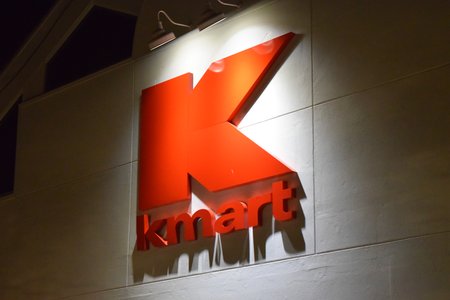
Externally-lit red Kmart logo on the front of the building. This external lighting is part of the shopping center’s standard design, as all tenants here had similar lighting setups.
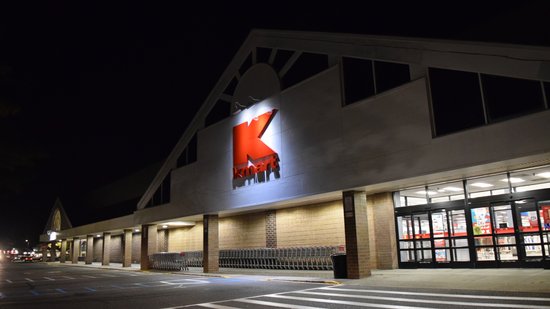
The front of the Bridgehampton store, at night just before closing.
And that was Kmart. From here, we started making tracks back towards our hotel, as Montauk Point and Kmart had been our big goals for this outing. We stopped in at a Burger King in Southampton for dinner, and we eventually found our way onto I-495 to get back to the city. We made a brief stop at the G Fuel headquarters building in West Babylon because Elyse wanted to see where it was (Elyse is a big G Fuel fan), and then we navigated the various freeways through Brooklyn and Queens to get back to our hotel. And that was our night.
Then the final day of our trip was the reason that we made it in the first place: the Historic Bus Festival put on by the Friends of the New Jersey Transportation Heritage Center organization, i.e. the bus show. Elyse wanted to get there early in order to get first dibs on the various merchandise that the vendors were selling, which, coupled with our later-than-intended return from Long Island (largely because of our late start), meant that sleep wasn’t going to really be much of a thing. I had gotten enough sleep to be able to function, but I really needed more than what I actually got in order to be at my best. And with a highly-motivated Elyse this time, we were definitely getting up early, because Elyse would make sure of it.
So we got up, got our breakfast, got packed, and then I got checked out of the room. If it tells you about what the difference is between an unmotivated Elyse and a highly motivated Elyse, this is how I left the hotel after checking out:
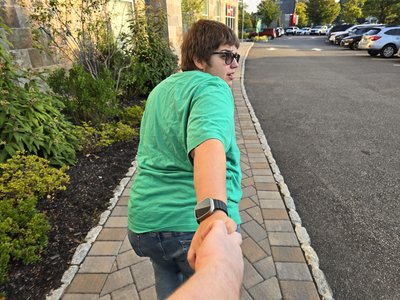
Yes, Elyse physically pulled me out of the hotel, and continued to pull me until we got to the car. Let’s just say that you do not want to get in Elyse’s way when in a highly motivated state.
It took us about an hour to get from Staten Island to St. Veronica’s in Howell Township, where the show was being held. Once we got out of New York, we took the Garden State Parkway for a hot second (just long enough to pay a toll, of course), and then took Route 9 the rest of the way. Once we got there, we parked the car, and then Elyse checked out the vendors, getting a few new model buses. Somehow, Elyse also managed to score a large Luminator front sign, which, as I understand it, will ultimately go to Commonwealth Coach & Trolley down in Roanoke.
As far as the bus show went, there were a lot of buses of various vintages, ranging from a 1946 GM to a modern New Flyer Xcelsior. From what I could tell, two transit agencies formally participated, with NJ Transit, as well as DASH from Alexandria’s both sending buses to the show. There were also a number of our friends who came, and some of them brought their own buses to the show. Elyse and I would have also shown off 3426, but it was not to be (but there’s always next time).
I’m not going to show everything right now (that will come out later on benschumin.com), but I want to hit the highlights. One thing that I made sure to see was the bus that Trevor Logan was bringing out, which was former Bee-Line bus 700, i.e. the bus that we would have ended up with had we followed through with our trade. I also got to pick his brain a bit about things to do for 3426 once we get it home, since this is not his first bus (he also owns and has restored a Flxible Metro, among others), and therefore he is a valuable source of advice on these things.
That said, here is Trevor’s bus:
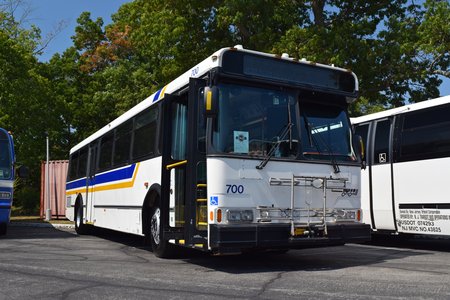
Trevor’s bus, former Bee-Line bus 700 from Westchester County, New York, a 2006 Orion V, which Trevor has nicknamed “Hunter”.
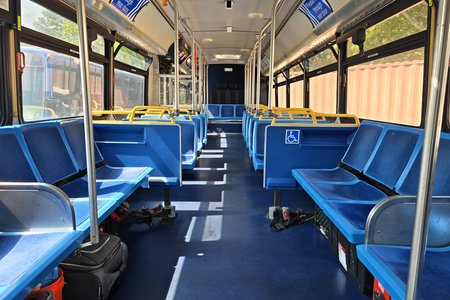
Interior of 700, facing the rear. As I understand it, the floor and seats are original, with the floor’s having received a very thorough cleaning. The seats, meanwhile, are awaiting restoration.
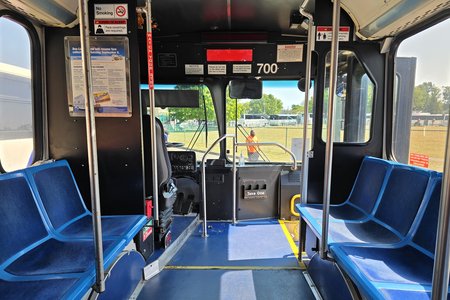
The interior of 700, facing forward. Note that large overhead mirror. I wish that I’d had an overhead mirror that big when I was driving Orion V buses. (My bus has a small overhead mirror right now, but we acquired a similarly-sized overhead mirror for it from a scrapper, and plan to swap it out once we get it home.)
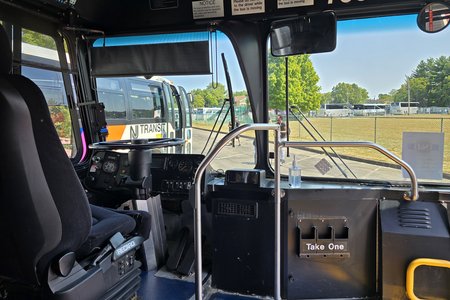
Operator’s compartment of 700. The dashboard is laid out a little bit differently than on the Orion Vs that I used to drive, but it still looked quite familiar.
Trevor also told us about a few things that he had done to 700 that we are considering doing for ours. One thing that he did was to replace the original bus PA system with a more modern sound system, installing new speakers behind the original covers while reusing the existing wiring, adding a new amp behind the operator’s seat, as well as a new head unit for it (that small box next to the dash). We plan to do similarly for 3426, though not right away. We located and purchased the same kind of farebox that 3426 originally had (a GFI Genfare CENTSaBILL), so our farebox is going to need to go in first, and then we will worry about a sound system. Trevor also told us about what he did with the floor on his Flxible, having that work done at a shop. Quite importantly, he also shared what he did with the wheelchair lift. As I understand it, best practice for the wheelchair lift on vintage high-floor buses is to simply disable the system and be done with it. Trevor also had some welding done on his bottom step, which contained the now-inoperative wheelchair lift, in order to rectify some sagging on that step, and now that step is rock solid (I jumped on it several times to test it). We have a similar problem with a sagging first step on 3426, so we’re most likely going to cut out the lift and weld it together as well. As it is, we had to fool around with the lift to get it to fully stow when we were down in South Carolina, so it only makes sense to render it inoperable and weld it.
Beyond Trevor’s bus, NJ Transit brought their bus simulator trailer to the show so that participants could get a feel for what it was like to operate a bus. Elyse, Kyle, and I all took a spin on it, getting a few minutes to pretend to operate a bus.
Elyse and Kyle were both given the most basic simulation, doing straight-line driving. Basically, you went up the road, driving the bus in a straight line, reacting to traffic, signals, and signage. The two of them both made some major errors while driving, as Elyse ran a red light, and Kyle hit a car while servicing a bus stop. Since I had mentioned that I actually had operated buses professionally before, they gave me a different simulation, where I had to follow a pickup truck around a few turns and things. I had fun with that, and despite the lack of a complete view (the left and right-side monitors were not working for some reason, so all we had was the front view), I got around all of my turns without going over the curb, and I didn’t touch anything else, either. And just like I always do when I’m driving the bus, I roped the wheel, i.e. steering as if I’m pulling rope, because that’s how I was taught. Then at the end of the simulation, the truck parked, and I parked the bus next to it and secured it. Good deal. I enjoyed the bus simulator. That was fun.
Then otherwise, besides socializing with other transit enthusiasts, I went down the line and photographed the buses of various vintages. The buses were arranged on three sides of a large soccer field on the property, so I started at one end and worked my way around. Here are some of the highlights:

2000 Gillig Phantom, owned by Rashalieque Sonnier. This was the only Gillig Phantom at the show.

Frank Cardona’s bus, a 2006 Orion V, one of four former Bee-Line buses at the show. Frank was the operator for the second half of the ride on bus 97 during the DASH Orion V farewell event.
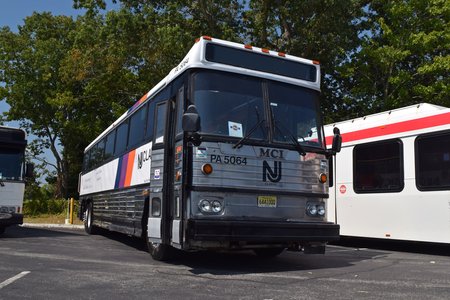
Former NJ Transit bus PA5064, a 1987 MCI MC-9B, now owned by Armond McFadden.
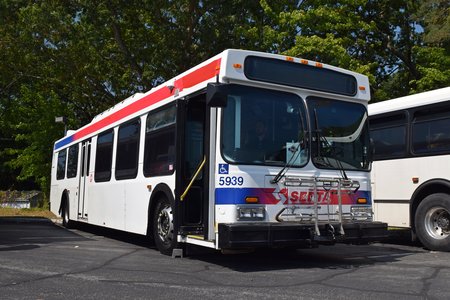
Former SEPTA bus 5939, a 2004 New Flyer D40LF, owned by Junior Mason. At the end of the event, Elyse and Kyle went out for a spin on this bus.
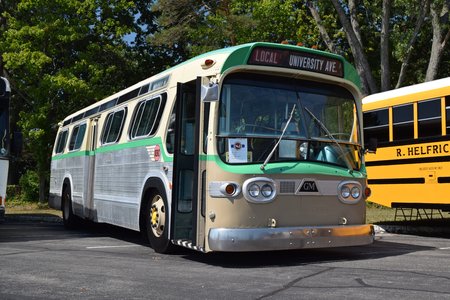
A 1966 GM TDH-4519, owned by Steven Olsen.

International school bus owned by R. Helfrich & Son, Inc. from West Keansburg, New Jersey, and is still in active service. This was the only school bus at the show, amongst what otherwise featured transit buses and motorcoaches.
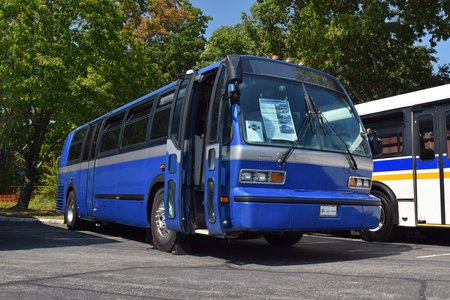
A 2002 NovaBus RTS, owned by Ron Stevens. This bus was formerly owned by Texas A&M University.
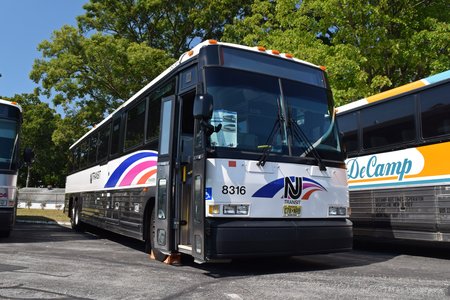
NJ Transit bus 8316, a 2002 MCI D4500, now part of the collection of Friends of the New Jersey Transportation Heritage Center.
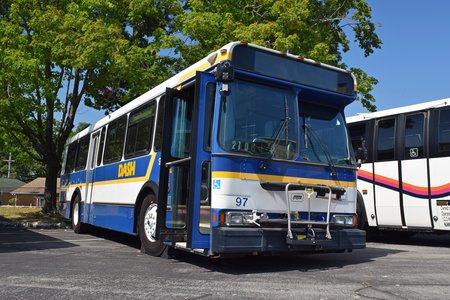
Former DASH bus 97, which we all rode on its last day of service a couple of years ago. This was the bus that would go up to the museum in Lakewood, New Jersey, and that same museum was the sponsor of this event. In any case, it was good to see it again.
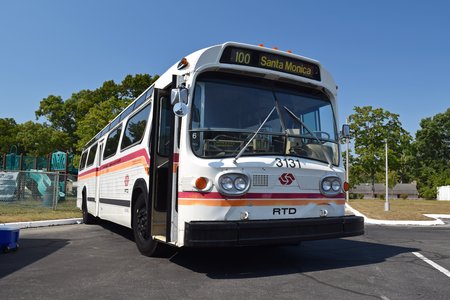
Former Southern California RTD bus 3131, a 1974 GMC New Look.

DASH bus 707, a New Flyer Xcelsior, wearing this year’s pride wrap. This bus was DASH’s formal participation in the show, and also operates in regular service for DASH.
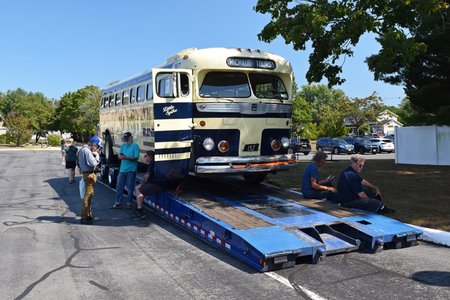
The oldest bus in the show was this one, a 1946 GM PD3703 owned by Chad Goertz. This was also the only bus that was brought in on a trailer.
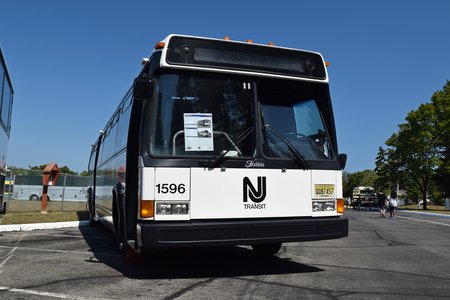
Former NJ Transit bus 1596, a 1980 Grumman Flxible 870. This bus is now part of the collection of Friends of the New Jersey Transportation Heritage Center.
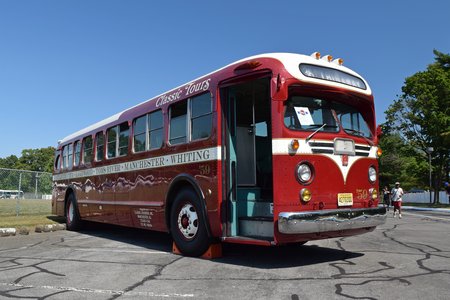
A 1959 GM Old Look bus, in Classic Tours livery.
At the end of the show, the buses departed in grand fashion, as the buses left one by one, going northbound on Route 9 for fans to photograph as they left. I photographed, while Elyse and Kyle rode out with the SEPTA bus. I’ll save those photos for the portfolio site, since the trip is not over yet.
Finishing up at the bus show, I headed over to Gaetano’s Steaks, a sandwich shop in Willingboro, where a group of people were going for lunch. Once the buses showed up, I took the drone out and flew around a little bit:
I also flew the drone around to get some low shots, like this of former Rabbit Transit bus 321:
The restaurant was pretty slammed due to the sudden influx of bus nerds that just arrived, so we didn’t eat there. We socialized for a while, and then we said our goodbyes and went on our way.
Our next stop was Philadelphia, where I was taking the drone around the SS United States once again. This was not my first time photographing the United States with a drone, but I treated it as if it was my last, and do get everything that I wanted now, because tomorrow was not guaranteed. For those not familiar, the owners of the United States have been involved in a legal dispute over rent payments with the owners of the dock where the ship has been berthed since 1996, and a judge ruled earlier this year that the ship would need to be moved by September 12. With that deadline in mind, Okaloosa County, Florida had expressed interest in acquiring the ship in order to sink her off of the coast of Florida for use as an artificial reef. However, interference from the dock’s owners have put all of that on hold, and a judge most recently has suspended the ship’s eviction deadline, and she remains where she has been. So with such an uncertain future, who knows if she’ll be there the next time I’m in Philadelphia, or if I would find an empty slip across from IKEA.
So with that in mind, I photographed the ship like it would be my last time, and got everything that I might have wanted. For a potential last outing with the United States, it seemed fitting that I took my photos of her at sunset (even though that’s just how things worked out).
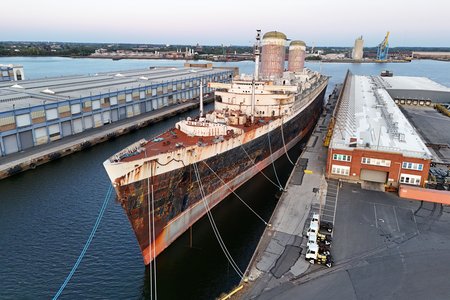
Approaching the ship immediately after taking off.
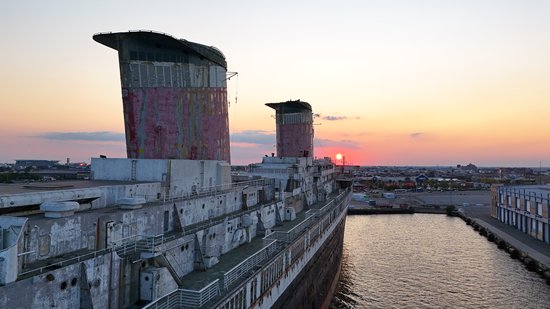
The funnels, with their unique “sampan” design. Elyse told me specifically to get good images of the funnels, as she liked them because she thought that they looked like baseball caps.

Shuffleboard court on the sports deck. This court would have looked like this when the ship was in service.
In accordance with the idea that this might be the last time that I got to photograph the ship, I went in for closer shots than I ever did in the past, dropping down to about 3-5 feet off of the deck in order to get a more human perspective of the ship. I started with the bow.

The forecastle of the ship, facing aft.
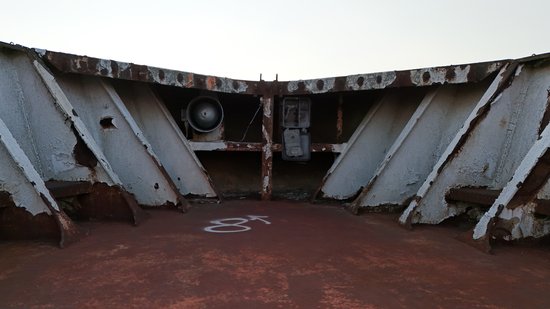
The very tip of the bow, viewed from 3-5 feet off of the deck.
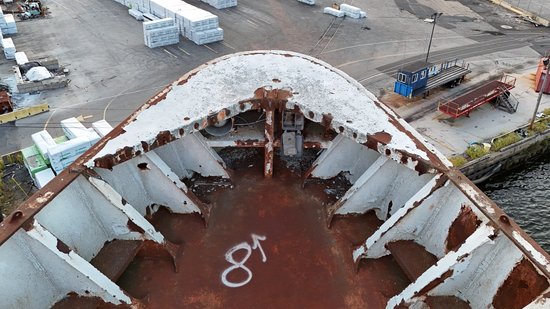
The tip of the bow again, from a little bit higher.
Then I went over to the stern to do similarly over there.
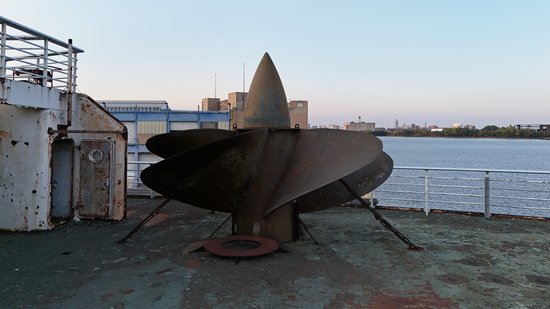
One of the ship’s propellers, secured on the fantail.
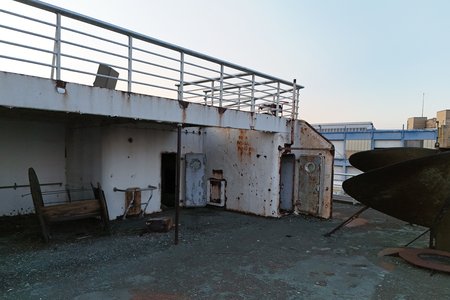
More decks forward of the stern.
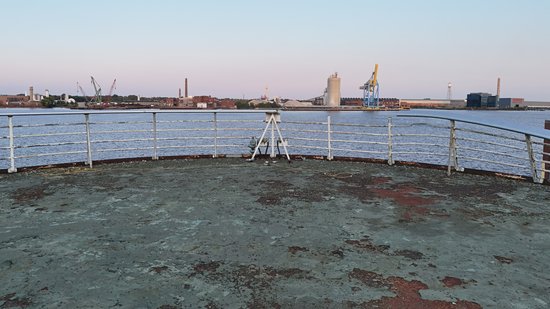
The railing around the fantail. Just out of frame to the right in this image, the railing is damaged, having been pushed inward and down. Don’t know what happened there.
Then I went around and got some low shots of the hull of the ship. I also learned my lesson from last December, where water splashing against one of the walls around the ship’s berth splashed over the top of my drone, shorting out the electronics and putting it out of commission for a period of time. While I was still able to fly it back to its launch site and recover it, the innards were fried. To prevent a recurrence, this time, I presurveyed any locations where I planned to drop down for low shots from above, and then dropped straight down instead of backing up towards the wall like I did before, making sure that I was clear of any walls.
I started out with the bow, going all around it from low angles.
I then went up and photographed the ship’s starboard nameplate, looking forward and aft.
Then I went over to the stern and got some low shots there. The stern is further away, but feels a bit safer to drop down around because it’s in a more open area, just as long as I stay clear of the ropes securing the ship to the pier.
And that was the end of what might be my final flight around the SS United States. All I had left to do was fly back and land.

View of IKEA while flying back.
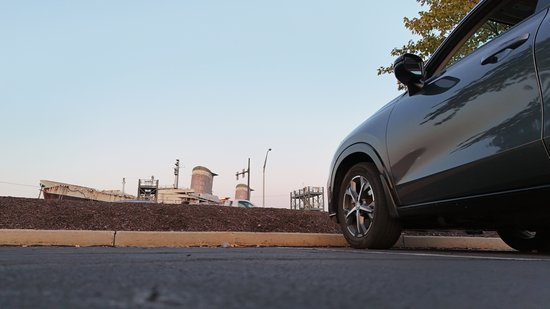
A post-landing shot of the ship at its berth and my car in the IKEA parking lot.
From there, I went into IKEA and had dinner:

My dinner at IKEA, where, for some reason, they were slightly more generous with the meatballs than usual.
And things more or less wound down from there. We made a stop in Christiana, Delaware in order to buy a new Keurig machine, since ours had recently died, but otherwise, that was the trip. This trip was quite successful, as we accomplished several miscellaneous outings that we weren’t able to justify on their own, plus we had a great time at the bus show. Next time, if all goes as I would like, we will have a bus of our own to bring to the show (and probably the only high-floor New Flyer at the show), which will make for an entirely different kind of trip. Don’t get me wrong – that kind of trip will be a lot of fun as well, but it won’t be the same as this trip.
Postscript: A week after our visit, on the day that this entry was published, the Kmart in Bridgehampton began its closing sale. That is discussed in this entry.
Categories: DASH, New Jersey, New York, New York City, New York Subway, NJ Transit, Philadelphia, Retail, Ships, Transit, Travel










